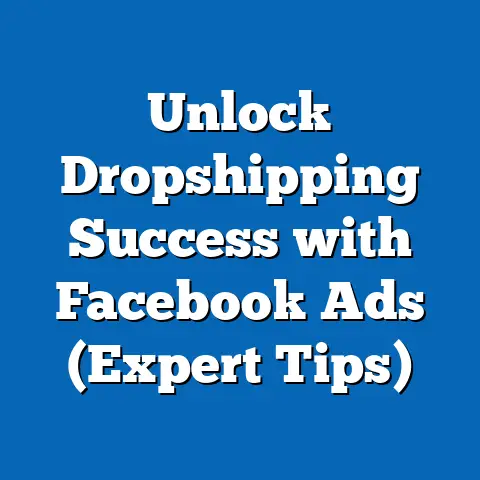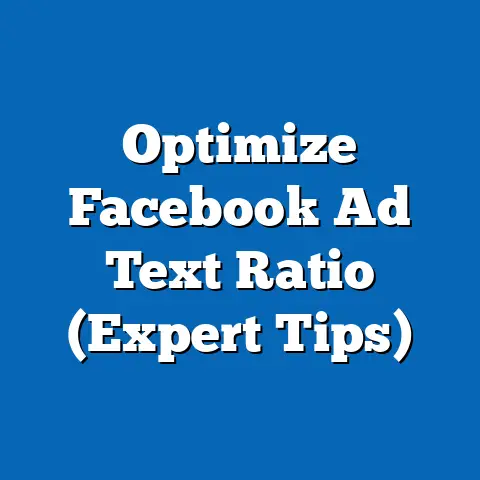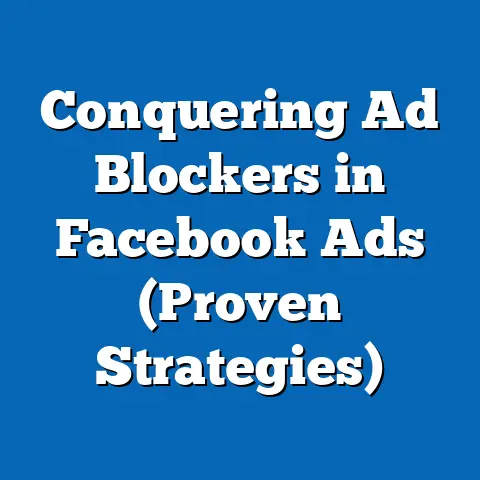Reduce fb ad Account Churn with Proven Strategies (Expert Insights)
Have you ever wondered why some flavors linger on your palate, creating a lasting memory, while others fade away almost instantly? The same principle applies to Facebook ads. Some ads resonate with your audience, driving engagement and conversions, while others are quickly forgotten, contributing to ad account churn. Just like a chef needs to craft a memorable dish, as advertisers, we need to create compelling campaigns that leave a lasting impression.
In this article, I’ll delve into the often-overlooked issue of Facebook ad account churn and provide you with actionable strategies to combat it. Churn, in this context, refers to the rate at which advertisers abandon their Facebook ad accounts, often due to perceived lack of success. It’s a costly problem, but one you can overcome with the right approach. Let’s explore how to create Facebook ads that stick!
Understanding Facebook Ad Account Churn
Facebook ad account churn is essentially the attrition rate of advertisers on the platform. It represents the percentage of businesses or individuals who stop actively using their Facebook ad accounts within a specific timeframe, usually a month or a quarter. This can manifest as pausing all campaigns indefinitely, deleting the ad account entirely, or simply reducing ad spend to negligible levels.
Why is this significant? Well, for Facebook, churn represents lost revenue and potential future growth. For advertisers, churn often signifies frustration, wasted investment, and missed opportunities. If you’re constantly losing advertisers, it signals underlying issues with the platform’s perceived value and the effectiveness of its ad tools.
The reasons for ad account churn are varied, but some common culprits include:
- Ineffective Targeting: Showing your ads to the wrong people is a surefire way to burn through your budget without seeing results.
- Poor Ad Performance: Ads that don’t capture attention or fail to convert will quickly lead to disillusionment.
- Budget Mismanagement: Running out of budget too quickly, or not allocating funds effectively across different campaigns, can lead to premature abandonment.
- Lack of Understanding: Navigating the complexities of Facebook Ads Manager can be daunting, especially for beginners.
- Changing Business Priorities: Sometimes, businesses shift their marketing focus to other channels, leading to inactivity on Facebook.
While precise churn rates are often kept confidential by Facebook, industry estimates suggest that a significant percentage of new advertisers discontinue their campaigns within the first few months. This highlights the importance of understanding the contributing factors and implementing strategies to improve advertiser retention.
Identifying Key Factors Contributing to Churn
To effectively reduce ad account churn, we need to pinpoint the specific factors that contribute to it. Here are some key areas to consider:
- Lack of Clear Objectives and Goals: This is where many advertisers stumble. Without clearly defined, measurable goals, it’s impossible to determine if your campaigns are successful. Are you aiming for brand awareness, lead generation, website traffic, or direct sales? Each objective requires a different strategy and set of metrics.
- Inadequate Audience Segmentation: Generic targeting rarely yields optimal results. You need to understand your target audience inside and out. What are their demographics, interests, behaviors, and pain points? Creating detailed audience segments allows you to tailor your ads for maximum relevance.
- Insufficient Ad Testing and Optimization: Facebook advertising is not a “set it and forget it” endeavor. You need to continuously test different ad creatives, copy, and targeting options to identify what resonates best with your audience. Ignoring this step is like trying to bake a cake without a recipe.
- Budget Allocation Challenges: How you allocate your budget can significantly impact your campaign performance. Are you spreading your budget too thin across multiple campaigns? Are you prioritizing high-performing campaigns? Are you adjusting your budget based on performance data?
I remember working with a small e-commerce business that was struggling with their Facebook ads. They were running a single campaign with a broad target audience and generic ad copy. They were frustrated with the lack of results and were considering abandoning Facebook advertising altogether.
After a detailed analysis, I helped them define specific goals (increased website sales), segment their audience based on past purchase behavior, and create multiple ad variations with targeted messaging. We also implemented a rigorous A/B testing schedule to identify the most effective ads. Within a few weeks, they saw a significant improvement in their campaign performance, and their churn rate decreased dramatically.
Proven Strategies to Reduce Churn
Now, let’s dive into the actionable strategies you can implement to reduce Facebook ad account churn and keep your advertisers engaged and successful.
A. Setting Clear Objectives
Before launching any Facebook ad campaign, it’s crucial to define your objectives clearly. What do you want to achieve? Are you looking to:
- Increase Brand Awareness: Reach a wider audience and build brand recognition.
- Generate Leads: Collect contact information from potential customers.
- Drive Website Traffic: Send people to your website to learn more about your products or services.
- Increase Sales: Drive direct sales through your website or app.
- Promote an Event: Increase attendance at an upcoming event.
Your objectives should be SMART:
- Specific: Clearly define what you want to achieve.
- Measurable: Establish metrics to track your progress.
- Achievable: Set realistic goals.
- Relevant: Ensure your goals align with your overall business strategy.
- Time-bound: Set a deadline for achieving your goals.
For example, instead of saying “I want to increase sales,” a SMART goal would be “I want to increase website sales by 20% in the next three months through Facebook advertising.”
B. Audience Segmentation
Targeting the right audience is paramount to success on Facebook. Don’t rely on broad demographics alone. Leverage Facebook’s advanced targeting options to reach the people who are most likely to be interested in your products or services.
Here are some audience segmentation techniques to consider:
- Demographics: Target people based on age, gender, location, education, and other demographic factors.
- Interests: Reach people based on their interests, hobbies, and passions.
- Behaviors: Target people based on their online behavior, such as purchase history, website visits, and app usage.
- Lookalike Audiences: Create audiences that are similar to your existing customers or website visitors. This is a powerful way to expand your reach and find new potential customers.
- Custom Audiences: Upload your own customer data (e.g., email addresses, phone numbers) to create custom audiences. You can then target these audiences directly or use them to create lookalike audiences.
I’ve seen so many times the power of a focused audience. One time I was helping a local bookstore that was running ads targeting “book lovers” in a 25-mile radius. We refined the audience using custom audiences from their email list and created a lookalike audience based on those customers. This change alone more than doubled their click-through rate and significantly lowered their ad costs.
C. Continuous Testing and Optimization
A/B testing is essential for identifying what works and what doesn’t. Test different ad creatives, copy, and placements to see which combinations yield the best results.
Here’s a framework for a testing schedule:
- Identify Key Variables: Determine which elements of your ads you want to test (e.g., headline, image, call-to-action).
- Create Variations: Develop multiple versions of your ads with different variations of the key variables.
- Run Your Tests: Launch your ads and track their performance.
- Analyze Results: Identify the winning variations based on your chosen metrics (e.g., CTR, conversion rate).
- Implement Changes: Incorporate the winning variations into your ongoing campaigns.
- Repeat the Process: Continuously test and optimize your ads to improve their performance over time.
Remember to only test one variable at a time to ensure accurate results. Also, give your tests enough time to gather statistically significant data before making any changes.
D. Budget Management
Effective budget management is crucial for maximizing your ROI. Consider these techniques:
- Daily vs. Lifetime Budgets: Choose the budget type that best suits your campaign goals and timeline. Daily budgets are ideal for ongoing campaigns, while lifetime budgets are better for campaigns with a specific end date.
- Budget Allocation: Distribute your budget strategically across different campaigns and ad sets. Prioritize high-performing campaigns and allocate more funds to them.
- Performance Monitoring: Regularly monitor your campaign performance and adjust your budget accordingly. If a campaign is underperforming, consider reducing its budget or pausing it altogether.
- Seasonal Trends: Adjust your budget based on seasonal trends and market demand. For example, you may want to increase your budget during the holiday season.
I once helped a client who was running a lead generation campaign for a software product. They were using a lifetime budget, but they weren’t monitoring their performance closely. As a result, they were spending a significant portion of their budget on days when their conversion rate was low.
By switching to a daily budget and monitoring their performance more closely, they were able to optimize their ad spend and generate more leads for the same budget.
Leveraging Data Analytics
Data analytics is your secret weapon in the fight against churn. By tracking and analyzing key metrics, you can gain valuable insights into your campaign performance and identify areas for improvement.
Here are some essential metrics to monitor:
- Click-Through Rate (CTR): The percentage of people who see your ad and click on it. A high CTR indicates that your ad is relevant and engaging.
- Cost Per Click (CPC): The average cost you pay for each click on your ad. A low CPC indicates that your ad is efficient and cost-effective.
- Conversion Rate: The percentage of people who click on your ad and complete a desired action (e.g., purchase, sign-up). A high conversion rate indicates that your ad is effective at driving conversions.
- Cost Per Acquisition (CPA): The average cost you pay for each conversion. A low CPA indicates that your ad is efficient at generating conversions.
- Return on Ad Spend (ROAS): The amount of revenue you generate for every dollar you spend on advertising. A high ROAS indicates that your ad is profitable.
Use these metrics to identify underperforming ads, audiences, and placements. Experiment with different variations and track the impact on your key metrics.
Engagement and Retention Techniques
Reducing churn isn’t just about acquiring new customers; it’s also about retaining existing ones. Here are some engagement and retention techniques to consider:
- Retargeting: Show ads to people who have previously interacted with your business (e.g., website visitors, app users). Retargeting is a powerful way to re-engage potential customers and drive conversions.
- Lead Nurturing: Provide valuable content and offers to leads who haven’t yet converted. This helps to build trust and credibility and increases the likelihood of a future purchase.
- Customer Journey Mapping: Create a visual representation of your customer’s experience with your business. This helps you understand their needs and pain points at each stage of the journey and identify opportunities to improve their experience.
- Loyalty Programs: Reward your loyal customers with exclusive discounts, offers, and benefits. This encourages repeat purchases and builds brand loyalty.
Real-Life Success Stories
Let’s look at some examples of brands that have successfully reduced churn through these strategies.
Case Study 1: E-commerce Fashion Brand
This brand was experiencing high churn due to ineffective targeting and poor ad performance. They implemented the following strategies:
- Defined clear objectives (increased website sales).
- Segmented their audience based on past purchase behavior and interests.
- Created multiple ad variations with targeted messaging.
- Implemented a rigorous A/B testing schedule.
As a result, they saw a 40% increase in website sales and a 25% reduction in their churn rate.
Case Study 2: SaaS Company
This company was struggling to retain new users after their free trial period. They implemented the following strategies:
- Developed a lead nurturing program to provide valuable content and support to trial users.
- Created a customer journey map to understand user behavior and identify pain points.
- Offered exclusive discounts and benefits to users who upgraded to a paid plan.
As a result, they saw a 30% increase in their customer retention rate and a 20% reduction in their churn rate.
Conclusion
Reducing Facebook ad account churn is an ongoing process that requires a strategic and data-driven approach. By implementing the strategies outlined in this article, you can create more effective campaigns, retain your advertisers, and maximize your ROI.
Remember the analogy we started with? Just like a chef needs to craft a memorable dish, you need to create compelling Facebook ads that “stick” with your audience. Define clear objectives, segment your audience, test and optimize your ads, manage your budget effectively, leverage data analytics, and engage and retain your customers.
Now, it’s your turn. Take these strategies and apply them to your Facebook ad accounts. Start by defining clear objectives for each campaign, segmenting your audience based on their interests and behaviors, and implementing a rigorous A/B testing schedule. The results might surprise you – and keep your advertisers coming back for more. By creating ads that resonate, you can build lasting relationships with your audience and reduce churn for good.






